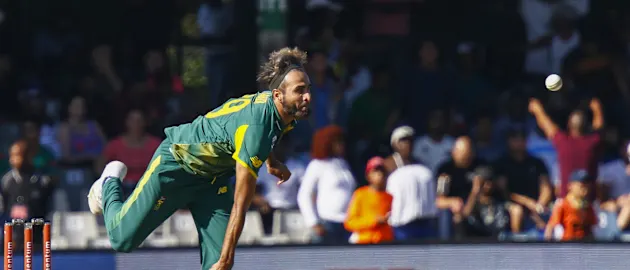Veteran No.1 Imran Tahir has nothing on 'Dainty' and the 'Gnome'


Earlier this month Imran Tahir became the oldest player ever to be ranked the top bowler in ODI cricket according to the MRF Tyres ICC Rankings. He edged ahead of Richard Hadlee, who was 38 years 250 days old when he last topped the table back in March 1990.
Old though he may be, Imran Tahir has nothing on the senior citizens who have topped the equivalent table in Test cricket. And perhaps even more astonishing is the fact that the two oldest bowlers to ever top the table played 12 Tests together from 1928 to 1933, taking 123 wickets at just 20.98 runs apiece. No mean feat, but all the more remarkable given that this was the age of Hobbs, Sutcliffe, Hammond, Headley, Herbie Taylor and Bruce Mitchell – batsmen who could all be classed as some of the greats of the game.
Clarrie Grimmett is perhaps best known as having never bowled a wide or a no-ball in a 37-Test career which saw him deliver 14,513 balls and take 216 wickets. In fact, in his entire first-class career contained just five wides and zero no-balls. He would hurry through his overs so quickly that his captains often complained that he did not give the fast bowler at the other end sufficient time to recover.
Born – ironically in Dunedin, New Zealand – on Christmas Day 1891, he emigrated to Australia in his 20s in search of international cricket. It finally came at the age of 33 and he quickly made up for lost time, taking 11 England wickets at Sydney to bowl his side to victory. Perfecting the art of the ‘flipper’ he mesmerised batsmen as he became the first man to take 200 Test wickets.
A haul of 11 wickets against the West Indies at Adelaide in 1930 saw him move to the top spot in the Test bowling table for the first time and he held onto that spot for most of the next five years. His final Test series came in the 1935/36 season against South Africa in which he took 44 wickets, including 13 in the series finale at Durban to take his points tally to 901 – the first Australian bowler to crack the elusive 900-point barrier. And that was that. At the age of 44 he was discarded by the Australian selectors while still at the peak of his powers. With Bill O’Reilly in the side, he wasn’t selected for the 1936/37 Ashes series but still plied his trade in the Sheffield Shield, ending with a tournament-record 513 wickets.
Late starter as Grimmett was, he was a mere slip of a man compared to his teammate who is the oldest man to ever top the ICC Test bowling table – Bert Ironmonger. Known as ‘Dainty’ he lost half of his left spinning finger in a childhood accident on his family’s farm, but he used the stump to great effect, imparting a large amount of spin on the ball.
His first-class debut came at the age of 27 but little was he to know that it would be nearly two decades before he would make his international debut. His high action extracted great bounce from the wickets and he took a hat-trick for Victoria against the touring MCC team at the MCG in February 1925. His toil in domestic cricket finally paid off when he was called up to the Australian side to face England at Brisbane in 1928 at the age of 46, when he sent down 94.3 overs in the match, taking four wickets.
After another unproductive outing a fortnight later at Sydney, he may well have thought his Test career over, and he was overlooked for the 1930 tour of England, despite the tour committee cabling the Australian Board in mid-May requesting an additional player (“another bowler of the type of Ironmonger or Chilvers to partner Grimmett”) but the Board turned them down.
However, he was recalled to face the West Indies in early 1931 and never looked back. In the fourth Test, on a rain-affected Melbourne wicket, he took 7/23, routing the visiting side for just 99. In the second innings, he took four more wickets to end the match with figures of 11/79. Better was to come the following season when South Africa were the tourists. He started with nine wickets in the Brisbane Test and seven more came at Melbourne. When the series returned to Melbourne for the final Test match, South Africa were bowled out for 36 in their first innings with Ironmonger taking 5/6. They fared only slightly better second time around, making 45 with Ironmonger taking 6/18. The spinner finished with 11/24 in the match and 31 wickets at 9.54 in the series.
Despite these remarkable efforts, he still trailed Grimmett in the bowling rankings. However, after taking 4/26 in England’s second innings of the 1932-33 Bodyline series at Melbourne – Australia’s only victory in the series – he nudged above his spinning counterpart. Finishing that series with a respectable 15 wickets at 27 each, he ended his Test career in top spot, at the age of 50 – the oldest man to top any of the ICC Rankings tables.
Despite being a poor batsman – he took more Test wickets than he scored runs – the story is told that his wife once phoned the MCG, and upon being told her husband had just gone in to bat, decided to hold! He was also possibly the worst fielder of his generation, but he still remains to this day the leading wicket-taker for Australia among left-arm spinners.
